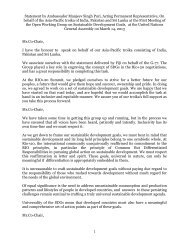STATE OF THE WORLD'S CITIES 2012/2013 Prosperity
STATE OF THE WORLD'S CITIES 2012/2013 Prosperity
STATE OF THE WORLD'S CITIES 2012/2013 Prosperity
You also want an ePaper? Increase the reach of your titles
YUMPU automatically turns print PDFs into web optimized ePapers that Google loves.
State of the World’s Cities <strong>2012</strong>/<strong>2013</strong><br />
Table 1.1.1<br />
Defining a prosperous city<br />
This involves reducing the incidence of slums and new<br />
forms of poverty. Prosperous cities are equitable and socially<br />
inclusive. The benefits and opportunities that come with a<br />
prosperous city are equitably (re)distributed. A prosperous<br />
city ensures gender equality, protects the rights of minority<br />
and vulnerable groups, and ensures civic participation by all<br />
in the social, political and cultural spheres.<br />
Fifth, the creation and (re)distribution of the benefits<br />
of prosperity do not destroy or degrade the environment,<br />
instead the city’s natural assets are preserved for the sake of<br />
sustainable urbanization.<br />
<strong>THE</strong> ‘WHEEL <strong>OF</strong> URBAN PROSPERITy’<br />
<strong>Prosperity</strong>, as defined by UN-Habitat, is a social construct<br />
that materializes in the realm of human actions. It builds<br />
deliberately and conscientiously on the objective conditions<br />
prevailing in a city at any time, wherever located and<br />
however large or small. It is a broader, wide-ranging notion<br />
that has to do with well-balanced, harmonious development<br />
in an environment of fairness and justice.<br />
As described above, prosperity takes in all urban<br />
functions as subsumed in five main categories. Since shared,<br />
balanced development is a crucial feature of prosperity,<br />
none of the dimensions must prevail over the others and<br />
all must be kept roughly ‘equal’ – for the sake of a smooth<br />
‘ride’ on the path of prosperity. In practice, of course, it is<br />
a rare city where the five dimensions will be found equal<br />
at any point in time, and this is where policy interventions<br />
will be called for, as suggested graphically by the profile<br />
of the city’s specific ‘city prosperity index’. For instance,<br />
A prosperous city is one that provides<br />
Productivity Contributes to economic growth and development, generates income, provides decent jobs and equal<br />
opportunities for all by implementing effective economic policies and reforms<br />
Infrastructure<br />
development<br />
Provides adequate infrastructure – water, sanitation, roads, information and communication technology in<br />
order to improve urban living and enhance productivity, mobility and connectivity<br />
Quality of life Enhances the use of public spaces in order to increase community cohesion, civic identity, and guarantees the<br />
safety and security of lives and property<br />
Equity and social<br />
inclusion<br />
Environmental<br />
sustainability<br />
Ensures the equitable distribution and redistribution of the benefits of a prosperous city, reduces poverty and<br />
the incidence of slums, protects the rights of minority and vulnerable groups, enhances gender equality, and<br />
ensures civic participation in the social, political and cultural spheres<br />
Values the protection of the urban environment and natural assets while ensuring growth, and seeking ways<br />
to use energy more efficiently, minimize pressure on surrounding land and natural resources, minimize<br />
environmental losses by generating creative solutions to enhance the quality of the environment<br />
14<br />
infrastructure may be well-advanced, but inaccessible to<br />
large portion of the population, therefore compromising the<br />
notion of equity. In other, frequent situations, a city may be<br />
economically efficient, enhancing job opportunities, but the<br />
natural environment is neglected.<br />
Since socioeconomic conditions keep changing on a<br />
local and a broader scale, they will have an effect on one or<br />
more of the five dimensions of prosperity, and it will be for<br />
policy interventions to restore the balance. In this endeavour,<br />
urban authorities will find that the various interlinkages and<br />
interdependencies between<br />
the five dimensions can<br />
also be of a positive nature.<br />
The ‘hub’<br />
For instance, provision FACT is made<br />
of the local urban<br />
of water and sanitation<br />
power functions, both<br />
in informal settlements<br />
public (municipal and<br />
will improve both equity<br />
other institutions and<br />
and quality of life, and<br />
agencies, laws and<br />
even the environment.<br />
regulations, including<br />
urban planning) and<br />
This points to the<br />
non-public (civil society,<br />
‘natural’ or ‘spontaneous’<br />
business, etc.).they<br />
interdependencies between combine in a variety of<br />
the five dimensions along<br />
ways according to local<br />
the outer rim of the<br />
needs and conditions,<br />
wheel. These can also<br />
with the synergies<br />
between them<br />
be strengthened with a<br />
resulting in innovative<br />
multiplier effect through<br />
institutional or policy<br />
deliberate, well-targeted<br />
practice, all for the sake<br />
interventions through the of the public interest<br />
‘hub’ of the wheel, i.e., the and shared prosperity.




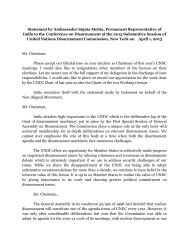
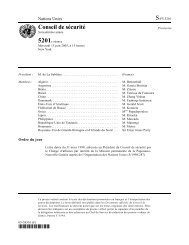
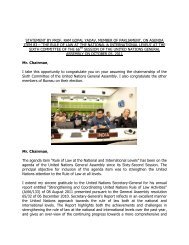
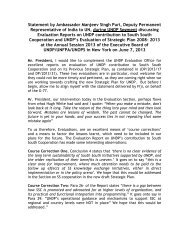
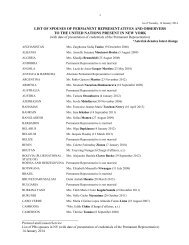
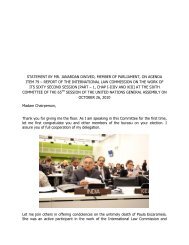
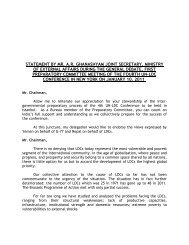
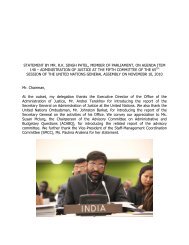

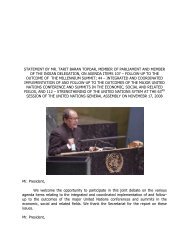
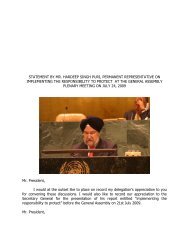
![1 statement by dr.[mrs] kakoli ghosh dastidar - Member States Portal](https://img.yumpu.com/27526598/1/190x245/1-statement-by-drmrs-kakoli-ghosh-dastidar-member-states-portal.jpg?quality=85)
